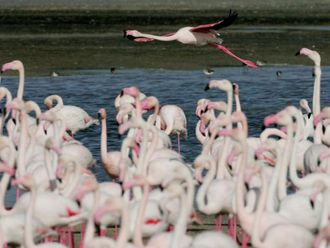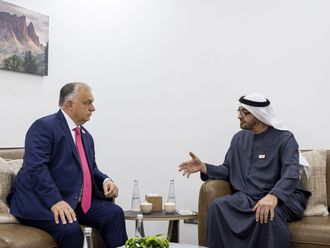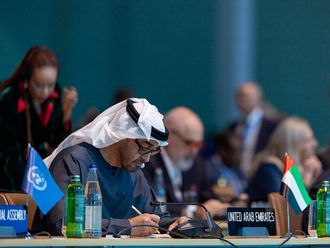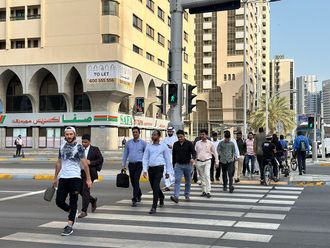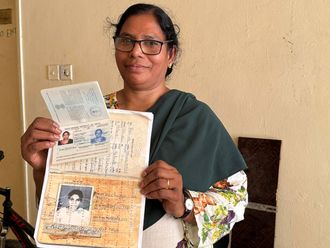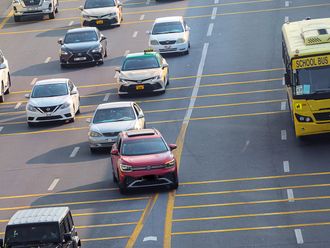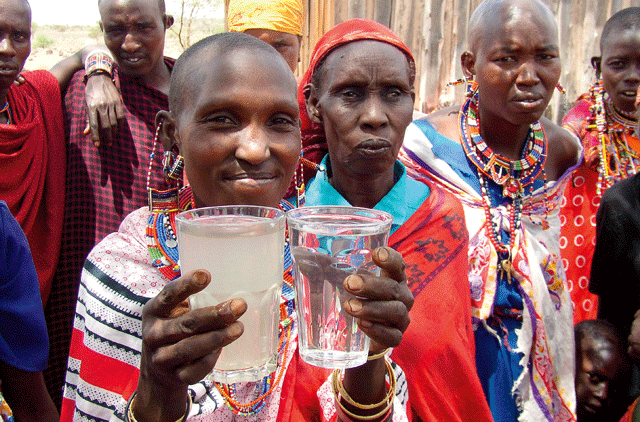
Dr Greg Allgood not only talks the talk, he also walks the walk. He will do almost anything to draw attention to the billions of poor people whose drinking water supply is so contaminated with bacteria and viruses that they are often sick, and sometimes die because of it. He's climbed mountains with film stars and musicians to publicise his cause; he's petitioned governments, he blogs, wanting to draw attention to a problem he feels must be solved with feverish urgency.
When I go to meet him, he does something that leaves me dumbstruck. He takes a glass of water, dumps all sorts of dirt and sand in it and stirs it up to create a slushy concoction. He then takes a small blue sachet from his shirt pocket, dumps its contents - a chalky white powder - into the glass and gives the slush another good stir. Five minutes later he strains the liquid - which is now dramatically clear water - through a piece of white cloth and proceeds to sip it.
Smile. Flash bulb moment. End of photo op.
For Dr Greg Allgood, this product, called PUR (see sidebar ‘How PUR works'), is just the beginning of his life's work. In Dubai to create awareness among the employees of P&G about the PUR project, Dr Allgood proceeds to tell us of conditions in developing nations in Africa, Asia and parts of Latin America, where safe and pure drinking water is at a premium. "Across the globe, more than 4,000 children die every day from diseases contracted by drinking unsafe water. This number is greater than the sum total of deaths due to diseases like malaria, and tuberculosis combined," he informs us.
Dr Allgood should know. He is the director of the Children's Safe Drinking Water programme at Procter & Gamble (P&G). He's been with P&G for 23 years and leads the company's efforts to provide safe drinking water in the developing world. He has a Master of Science in Public Health from the University of North Carolina - Chapel Hill and a PhD in Toxicology from North Carolina State University.
Why is he associated with one of the world's largest multinational consumer product giants? Is there a catch? Dr Allgood says there is none. He's totally committed to looking for solutions to the global crisis on drinking water.
The surprising thing about PUR, says Dr Allgood, is that it was first developed by P&G to be marketed like any of its regular products. But somewhere along the way the company decided to convert what was a commercial product into a not-for-profit venture. He wears a broad smile as he details the set of circumstances that led to this happy decision.
"It was a new idea for us because essentially we are a for-profit company," he says. "So, we needed to have a strong rationale (for doing it differently). In fact, we believe the product has added great value to P&G by saving lives as our company believes in touching and improving lives. It is about altruism, and typically it has inspired our 135,000 employees who love this programme. This is a very big source of pride for us. We have been thanked by presidents and kings for our contributions. Former US President Bill Clinton said last year that no other issue kills more children than unsafe drinking water and nobody is doing more to address it than P&G. I am not sure if that is entirely true, but the fact that he would include us in the groups that are trying to do a lot in the water crisis issues is great!"
Even before P&G turned the PUR project into a philanthropic one, Dr Allgood could see that it would make a big difference in the lives of the underprivileged. "I recommended to the company that if we were successful in marketing the product, we also have to be able to provide it where P&G does not have the infrastructure, because this is a life-saving project," he says.
"I felt it should be available in case of emergencies in such areas. That was always our strategy. But I never imagined that we'd only do the latter and not have a commercial business."
His unequivocal involvement in the project happened in an entirely logical manner. "The defining moment came when I was leading our partnership effort early on," he says. "We were on one of our field trips to Kenya in 2003, a year after we started producing PUR. We were distributing PUR packets to people at a village where they collect drinking water from shallow ponds, rivers and springs. At one particular shallow pond a woman was collecting water with her family when we demonstrated to her the efficacy of PUR. Her happiness was unbounded when she saw the dirty slushy water turn clean.
"Even as we were talking to her after the demo, a man who had been standing nearby watching us came running and before we knew it had snatched the bucket of clean water from her and ran away. The woman pleaded with us to give her more sachets of PUR."
It is a moment etched in his mind. "We have had a lot of such moments, but this one certainly was the defining moment for me and I decided I would dedicate my career to making the product available to as many people I could and save lives."
That was also the point when P&G was working very hard to market PUR. "We were losing money on it and we were at crossroads," says Dr Allgood. "We had to decide what to do with the product and so when this incident happened it made us see how we could reach people like the woman at the shallow pond and how it could become a worthwhile effort. So in 2004 we went not-for-profit with it."
Dr Allgood recommended to the company to dedicate a small team for the distribution of PUR through humanitarian groups already working in those areas.
"We worked with organisations like Unicef, Cooperative for Assistance and Relief Everywhere, Inc (CARE), Population Services International (PSI), and Save The Children. Today we have a hundred different partnerships with various organisations to move on with this project for clean drinking water."
The need for the product increased exponentially when it became not-for-profit. "When we were providing it commercially we sold about 1 million packets a year. This year we have already provided 60 million sachets. The company is tripling its production capacity and we will be providing 100 million packets next year. That amounts to 100 times more than what we were doing in 2002-03."
Dr Allgood lists the tangible results of the programme: "Between 2004 and now, we have provided 200 million packets which were used to treat 2 billion litres of water. The countries covered have been Kenya, Pakistan and Indonesia. In each of these places, through studies conducted by the US Government's Centres for Disease Control (CDC) and John Hopkins University, we can calculate every year the reduction that has occurred in illnesses. So we know that those 2 billion litres of water have saved more than 11,000 lives and prevented more than 79 million days of illness."
Dr Allgood is a realist, and agrees that it is still a small number compared to the number of children that die every day, around 4,000.
"This number may be small, but each of those lives is very meaningful," he ponders. "It took us four years to provide the first billion. Two years to provide the next billion, and now a year to provide the third billion. We continue to save more lives."
His and P&G's commitment is to treat 4 billion litres of clean water by 2012, which Dr Allgood estimates would save 20,000 lives. "P&G typically meets its goals and this has the full support of the board. So I am very confident that we are going to meet this goal."
Of course Dr Allgood agrees that it is a very ambitious goal. And to that end the P&G programme is spreading its wings and also trying to get governments involved in the project.
"We are in the process of getting registered in India to take the programme there," he says. "The first role of a government is in approving the registration which will allow us to work there. Their second role is enabling us to gain access to our target audience through institutions such as schools. For instance, if a school doesn't have safe drinking water the kids won't go to school. So, problems can be synergetic. To get into schools you need the permission from the ministry of education. This is where the governments come in."
Dr Allgood believes children are great change facilitators and they can help synergise change through communities. "Each country may have different reactions, strategies and policies, but the important thing is helping in the effort. Whether it is through schools or other community initiatives, the aim is to provide safe drinking water."
P&G has marked 2015 as the year when they expect to have saturated effort in most developing nations. "Even if we are successful, which we well might be, there will still be millions of people who would need access to safe drinking water," says Dr Allgood.
"And when I say safe drinking water, I mean by the standards of Unicef. A lot of that accessed source is not safe water. For instance, in Pakistan, many people have water provided in the house. We did a study and found 64 per cent of the citizens have access to water. But clearly that water is not safe drinking water. In the US too the water infrastructure is ageing; many a time the water that reaches homes is not safe. Other times the sewage line and the water line are in the same ditch and because it is not always positive pressure, the sewage will get into the water line."
On his blog, an exercise that has been a learning experience for him as he struggles to overcome his reluctance to write, he expresses emotions that are a direct result of the problems he encounters among people. "I am not a natural writer, it's tough," he admits about his blogs.
"I promised myself when I started the blog that I will be honest with my emotions. So when I see something very sad, I try and be open and candid about it." His efforts are however showing results as the tremendous feedback his blogs generate reveals. "One person who read it, got so inspired that she wanted to be a part of the team. But we didn't have an opening, so she worked out her own plan and convinced our people in the US to start a coupon scheme offering discounts on P&G products. Every time they used the coupons, P&G would set aside certain number of PUR water treatment packets for distribution. In fact, it turned out to be one of the company's most successful campaigns."
But he does not see this journey from profit to not-for-profit as his driving force alone. Causes, he believes, can succeed only when all entities do their bit. "Working on this project has humbled me," he says simply. "It has shown me the power of a company like P&G to do very great and good things. It has also taught me how the private sector can work with governments and address some key global issues."
He cites just one instance of this kind of a collaboration. "In Malawi there would be cholera outbreaks every year. We chose that place to work on, together with the government. We provided PUR packets through schools and mobilised its promotion through women who distributed it in communities. After a while, when we conducted a survey, we discovered that there was a 50 per cent decrease in diarrhoea cases and a 50 per cent decrease in school absenteeism. The community realised the power of group work, and got together and mobilised enough resources to build drains in schools and communities.
"The results are so visible. When a mother sees the difference in the health of her children and she gets mobilised whether it is help build drains or learn the discipline of regular hand washing to stay hygienic" it's proof that the programme is working, he says. "When you see the public being mobilised, it truly inspires you to keep going."
How PUR works
P&G developed PUR Purifier of Water in collaboration with the US Centers for Disease Control and Prevention (CDC).
PUR is a small sachet of powdered ingredients that make contaminated water potable through coagulation and disinfection. It uses the same approach and ingredients as many municipal water-treatment facilities — the two primary components are ferric sulphate, a well-known and widely used coagulant, and calcium hypochlorite, a disinfectant.
Through extensive lab and field testing, it has been proven to eliminate turbidity, chlorine-resistant parasites, viruses, bacteria and pollutants like arsenic.
Five clinical studies were conducted with the CDC and the Johns Hopkins University to prove the product's efficacy. These studies, involving more than 26,000 people, were conducted in four different countries and in a broad range of settings. They looked predominately at the reduction in the incidence of diarrhoea when people were provided safe water treated with PUR (compared to their normal habits).
The results of these studies showed that the PUR packets led to up to 90 per cent reduction in the incidence of diarrhoea.
PUR has been distributed on a not-for-profit basis since 2004 through P&G's philanthropic effort called the Children's Safe Drinking Water programme (CSDW). CSDW is the signature programme of P&G's Live, Learn, and Thrive cause that helps children in need around the world.
Since 2004, P&G and its CSDW partners have provided more than 130 million sachets — enough to purify 1.3 billion litres of water. Efforts in this area are continuing, and P&G has committed to provide more than 3.5 billion litres of purified water (350 million sachets of PUR) by 2012.
Why PUR sachets?
"In most developed countries, the water is brought into municipal treatment plants, then passed on to the consumers. The PUR packets contain exactly the same ingredients; what we've done is reverse the process to put the same thing in a packet," says Dr Allgood. "There is nothing new that we have developed. We just figured a way to put them together so that they stay stable, and can be used in small quantities to make the water safe.
"It allows us to quickly reach people who don't have access to pure drinking water. It is easy for us to transport it to places where people for many generations to come will still not have clean drinking water unless they use agents like these."
PUR is available as a 4g sachet. "This product is extremely effective in killing the bacteria, viruses and parasites, up to 99.99 per cent in most cases," says Dr Allgood.
Do you know of an individual, a group of people, a company or an organisation that is striving to make this world a better place? Every responsible, selfless act, however small or big, makes a difference. Write to Friday and tell us who these people are and what they do. We will bring you their stories in our weekly series, Making A Difference. You can email us at friday@gulfnews.com or to the pages editor at araj@gulfnews.com


